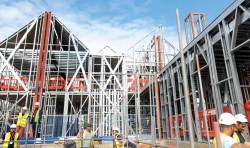Our guest contributor Steph Hazlegreaves, digital managing editor for PBC Today answers some opportune questions and explores whether light steel framing is truly the most technically advanced material in the offsite technology portfolio.
Offsite technology has made significant advancements in recent years, with light steel framing emerging as one of the leading materials. Light steel framing offers a variety of advantages over traditional construction methods such as faster assembly times and increased design adaptability. It is quickly becoming an attractive option for developers looking for efficient building solutions within project budgets.
What are the Advantages of Using Light Steel Framing?
Light steel is a type of construction that has become increasingly popular in recent years due to its increased durability, cost-effectiveness and versatility. It is often used for framing materials in offsite technology applications such as modular building systems or prefabricated components.
Not only are systems lighter than their counterparts allowing for easier transportation, but the price point is also generally lower making them attractive choices for projects with tight budgets. Light steel framing provides cost savings when compared to traditional stick-framing, as well as increased design flexibility and faster build times.
Additionally, light steel frames require less maintenance than other forms of construction. The main advantage of using light steel framing is its strength. The metal components are designed to be extremely tough and stable, meaning they can withstand high loads with minimal deformation over time. Furthermore, because the frame assembles quickly and easily on site, it reduces labour costs significantly. As a result, light steel frames offer greater economic benefits than conventional building materials such as timber or concrete blockwork.
In addition to being strong and economical, light steel frames also provide excellent thermal insulation properties due to their airtight nature. Moreover, the frames have exceptional acoustic performance which makes them suitable for use in areas where noise pollution needs to be reduced or eliminated altogether.
What is the Environmental Impact of Light Steel Framing?
As the construction industry continues to prioritise green building solutions, light steel framing has become increasingly attractive as an environmentally friendly material option. This type of steel framing offers several environmental benefits that make it well suited for numerous applications in both residential and commercial buildings.
One of the primary advantages of light steel is its high levels of recyclability. Steel production requires large amounts of energy, but when steel is reused or recycled, this reduces the overall amount of energy needed for manufacturing new materials. Additionally, since lightweight steel frames are made from thin sheets cut into specific sizes, so there is much less waste generated during installation than with traditional timber framing methods.
The use of light steel also allows for more efficient insulation systems compared to other materials used in offsite technology portfolios such as concrete or masonry blocks. Lightweight metal studs create air pockets that can be filled with insulation which helps reduce heat loss through walls or roofs and increases thermal efficiency within a structure's envelope. Furthermore, since these structures require fewer resources to build and maintain while providing greater durability over time, they often have longer lifespans resulting in lower long term costs associated with upkeep and repairs.
Overall, light steel provides many environmental benefits. Its low weight facilitates easy transport and quick assembly on site while its ability to support multiple types of finishes makes it suitable for a variety of design options allowing architects greater scope in their designs without compromising sustainability goals. In addition, its excellent thermal properties offer significant potential savings in terms of heating and cooling costs throughout the lifespan of light steel buildings.
What are the Design Considerations When Using Light Steel Framing? The use of light steel framing in offsite technology can be likened to a finely tuned instrument, providing the perfect blend of design flexibility and structural integrity. When considering this material for construction projects, there are several key design considerations that must be taken into account:
• Building Regulations: Light steel frames meet all building regulations standards, ensuring safety and security for occupants.
• Design Adaptability: Due to its strength-to-weight ratio and ease of installation, light steel frames offer greater versatility when it comes to designing complex structures.
• Loadbearing Capacity: Light steel is one of the strongest materials available for loadbearing capacity, making it an ideal choice for large scale projects such as commercial or multi-storey buildings.
How Does Light Steel Framing Compare to Timber Framing in Terms of Durability?
Light steel has far greater strength than timber framing when it comes to resisting movement due to wind loads or seismic activity. In addition, light steel is non-combustible and can stand up better against fire than many other types of construction materials. These qualities make it an excellent choice for projects where safety and performance are top priorities. When comparing the two materials, light steel offers several advantages over timber framing:
1. Steel does not shrink or expand due to changes in humidity and temperature levels.
2. Steel frames require less maintenance since they do not need painting or staining.
3. Steel is lighter than timber but still provides sufficient structural support for larger buildings.
4. Steel frames offer superior soundproofing capabilities as metal absorbs sound waves much better than timber.
Future Trends and Opportunities for Light Steel Framing
The continued growth of light steel framing is expected to open up new avenues for collaboration among industry professionals. As more companies begin to recognise the advantages of using lower cost yet highly durable steel frames. Furthermore, advancements in digital technologies could enable more efficient design processes, thereby further expanding the scope of possibilities available through offsite technology. These developments present an immense opportunity for those involved in projects utilising light steel frame.
For more information visit: www.pbctoday.co.uk
IMAGES
01. EOS Framing, Gardiner Place
02-03. Light steel frame construction has become increasingly popular in due to its increased sustainability, durability, cost-effectiveness and versatility.









